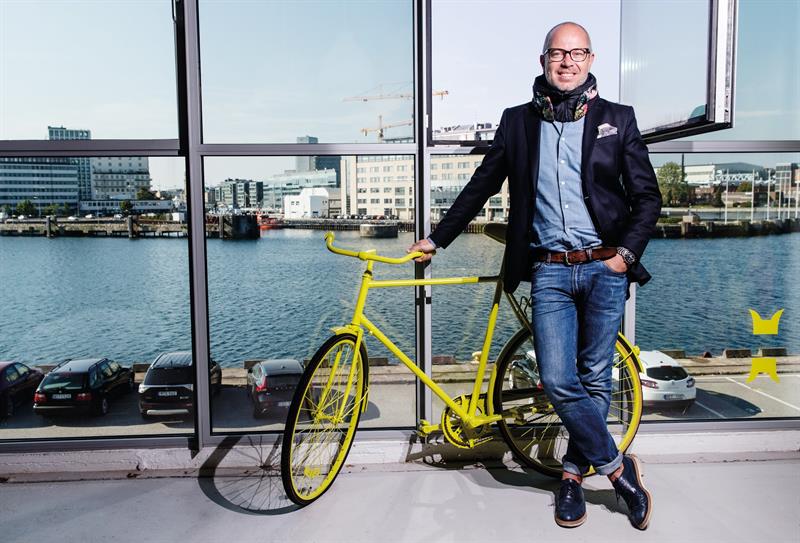But as important as it is to protect one’s head while cycling, not everyone is willing to wear a traditional helmet. Whether because of comfort, fashion or the ongoing debate about how effective polystyrene and polyurethane helmets are, many prefer not to don a helmet before jumping on their bikes.
For this reason, Hövding, has been trying to offer an alternative since 2012 in the form of an airbag ‘helmet’.
First devised in 2005, Hövding’s cycling airbag is now in its second generation and has sold nearly 90,000 units worldwide.
 Hövding chief executive, Fredrik Carling (pictured, left) says: “Our main aim has always been to make cycling more accessible while keeping people safe. We know that half of our customers never wore head protection before discovering our product.”
Hövding chief executive, Fredrik Carling (pictured, left) says: “Our main aim has always been to make cycling more accessible while keeping people safe. We know that half of our customers never wore head protection before discovering our product.”
So what gaps are Hövding’s technology filling? Helmets today are moulded and mostly produced in expanded polystyrene or polyurethane, but the materials and design have some drawbacks. They don’t protect the jaw, the back of the head, the neck or ears in case of a collision with a sharp object. And, because the cover and the body of the helmet is made of an inelastic hard material, they don’t absorb the force of the collision optimally. So even if the head is not injured, there is still a risk of brain damage in more serious accidents.
“Stanford University conducted some research that looked at the effectiveness of a number of head protection products and compared Hövding directly to cycling helmets. This was done via a simulation of the most common cycling accident – a single fall.
“This study found that Hövding provides eight times better protection against a risk of concussion and head injuries than that of traditional helmets,” says Carling.
Swedish insurance firm Folksam, also conducted tests into the airbag technology compared to traditional helmets. It found that in impact tests run at 25km/h conventional helmets achieved g-forces of 196-294 g, Hövding’s airbag achieved 65 g.
Much of that improvement is due to the elasticity of the airbag material, but it wasn’t as simple as taking technology from other industries, such as automotive, and directly applying it to Hövding’s system.
“The outer fabric of our airbag is taken from the automotive industry. It is highly tear and abrasion resistant, however it leaked air too fast. We understood early on that it needed to be different from airbags, as they only need to absorb acceleration for a short period of time.
“We needed to have an airbag that stayed inflated for longer. Hence an inner plastic bag was added to keep the air inside the bag for longer. Hövding retains its protective capacity for 5-10 seconds, in order to withstand multiple impacts – for example a car’s windshield, followed by rolling off the bonnet and then onto the road,” explains Carling.
 Once the airbag technology had been defined, it was the turn of the underlying algorithms that determine situations such as whether a crash is happening and controlling whether or not the helmet is inflated.
Once the airbag technology had been defined, it was the turn of the underlying algorithms that determine situations such as whether a crash is happening and controlling whether or not the helmet is inflated.
Carling is less willing to comment on the base software and whether Hövding used code already available and built it up from there, or whether the firm started from a blank sheet of paper. However, the system does take information from both an accelerometer and gyrometer, collating measurements and assessing the situation.
The underlying algorithm was written based on a huge amount of data accumulated during the first generation airbag’s development.
“We mapped all known bicycle accidents using available statistics. We then re-enacted them with stuntmen and stuntwomen. Over 2,000 accidents were staged in this manner. We also collected general data and movements from everyday cycling, for example without people coming off their bikes. Both of these steps were taken with the very same sensors that can be found in the collar today,” says Carling.
The onboard sensors and software take 200 readings a second, comparing it to the accumulated data and underlying algorithms to decide if an accident is going to occur. Should it detect something, the bag can inflate in 0.1 seconds.
False positives are obviously of most concern, not only because they will reflect badly on the technology, but also because once the airbag fires it cannot be used again and has to be replaced. This is expensive for the end user when the technology costs £219.
Smoothing out the software so it could differentiate between a real accident and the general unevenness of cycling was a challenge and has been noted as such by some that have tested the device.
“It was a very complex process. It took us five years to refine and perfect the technology. Only a very small number of the 87,000 airbags that the company has sold worldwide have inflated accidently. We call it a faux positive inflation. From our experience, in the vast majority of these cases, it happens when a cyclist is trying to avoid an accident,” says Carling.
Hövding does receive data back from units that have fired and this is fed back into the development programme and used to improve future generations of the airbags.
“We have a team of in-house mathematicians and programmers who then review the new data. It’s collated and fed back into the programming on our internal system for it to be plugged in and analysed,” says Carling.
The data isn’t just used to improve the airbag’s algorithms in the event of an accident, but also so it can remain stable even when cyclists are riding different types of bicycles and the nuances between them.
“Our initial model, the Hövding 1.0, hadn’t been programmed to read foldable or electric bikes. Since the release of our 2.0 model in 2012, this has been upgraded to include those two types of bike,” says Carling.
The hardware of Hövding’s airbag is unlikely to change dramatically as it is a known quantity, but the company will continue to feed data back into its software, developing updates and making improvements.
If cycling is to continue its rise in popularity then safety will become an increasingly important aspect for discussion, and technologies that protect riders’ heads will be at the top of the list.











